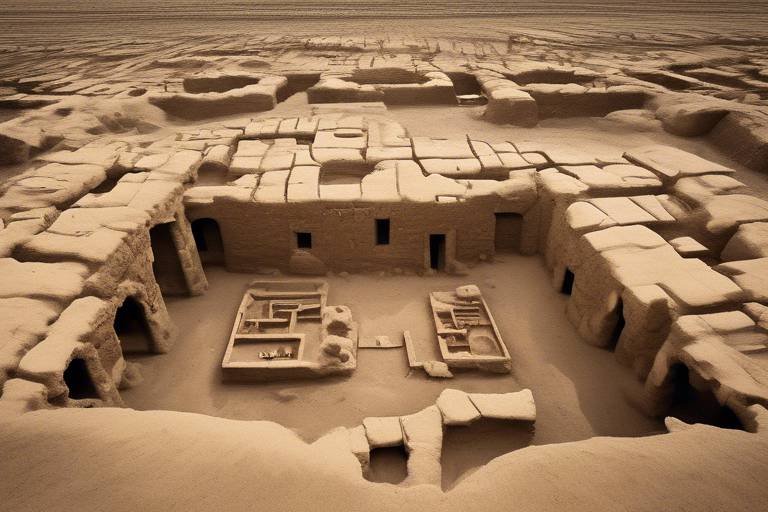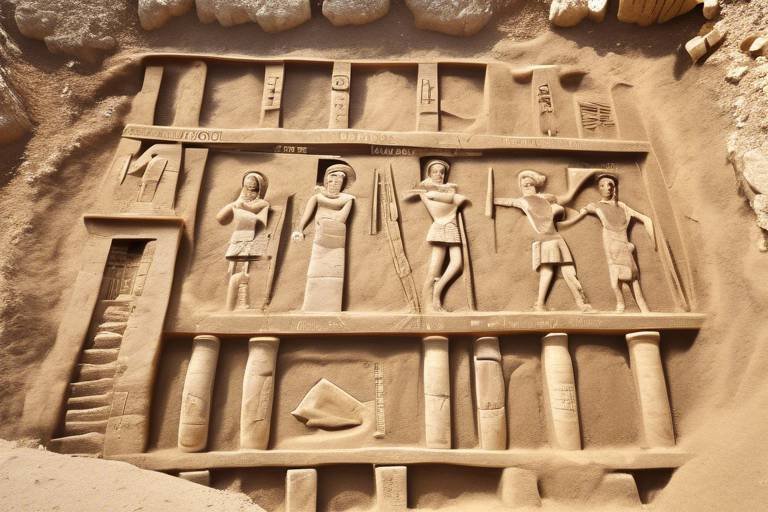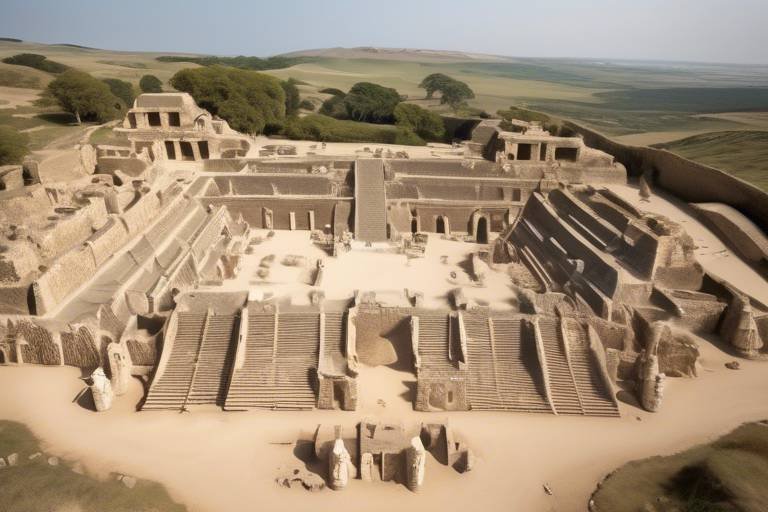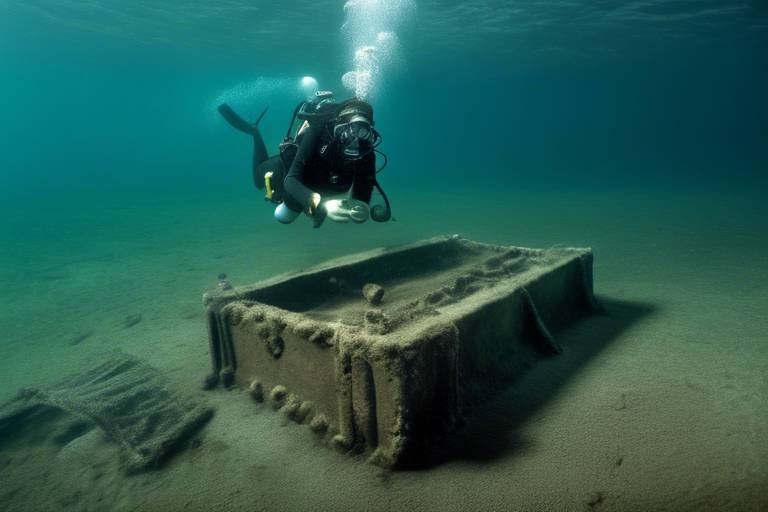Addressing Climate Change Through Archaeological Research
Climate change is one of the most pressing challenges of our time, impacting ecosystems, economies, and societies worldwide. Addressing this global issue requires a multidisciplinary approach that leverages diverse sources of knowledge, including insights from archaeological research. By delving into the past, archaeologists can uncover valuable information about how ancient civilizations coped with changing climates, offering lessons that are relevant for shaping modern climate change mitigation strategies.
Through the study of ancient civilizations, researchers can gain a deeper understanding of the profound effects of climate change on human societies. By examining archaeological sites and artifacts, they can trace the ways in which past communities adapted to environmental challenges such as shifting weather patterns, droughts, or floods. These insights provide a historical perspective on resilience and innovation in the face of climatic disruptions, offering inspiration for contemporary efforts to build sustainable societies.
One of the key tools in archaeological research is the analysis of pollen and plant remains found at excavation sites. By studying these organic materials, scientists can reconstruct past climates and vegetation patterns, shedding light on historical climate variations. This data not only helps in understanding how ecosystems have evolved over time but also provides crucial information for predicting future climate trends and their potential impacts on biodiversity.
Ice core samples extracted from glaciers and ice sheets serve as time capsules of Earth's past climates. These samples contain layers of ice that preserve atmospheric gases, dust particles, and other indicators of past environmental conditions. By analyzing these ice cores, researchers can unravel detailed records of temperature changes, atmospheric composition, and even ancient volcanic eruptions. Such data is instrumental in refining climate models and improving our understanding of long-term climate dynamics.
Human migration patterns have been intricately linked to changes in climate throughout history. By investigating archaeological evidence of population movements, researchers can discern how environmental factors such as droughts, famines, or natural disasters have influenced the dispersal of human communities. Understanding these historical migration patterns can offer insights into the complex interactions between climate change and human behavior, informing contemporary debates on climate-induced displacement.
Coastal archaeological sites provide valuable insights into the impact of sea-level rise on past societies. By studying submerged remains and coastal settlements, archaeologists can reconstruct ancient landscapes and map out the effects of changing sea levels over time. These findings are crucial for informing coastal management strategies and adapting to the challenges posed by rising seas in the context of modern climate change.
Dendrochronology, the study of tree rings, offers a precise method for dating past events and reconstructing environmental conditions. By analyzing tree ring patterns, researchers can create accurate timelines of climate variations, including droughts, fires, and other disturbances. This data not only helps in understanding short-term climate fluctuations but also provides insights into the long-term trends shaping our planet's climate system.
Reconstructing ancient landscapes through archaeological evidence allows researchers to visualize past climate conditions in vivid detail. By piecing together geological, botanical, and anthropological data, scientists can create immersive depictions of ancient environments, complete with flora, fauna, and human settlements. These reconstructions not only offer glimpses into the past but also inform conservation efforts aimed at preserving biodiversity and cultural heritage in the face of ongoing environmental changes.
Preserving cultural heritage sites is paramount in safeguarding our shared human history from the threats of climate change. Archaeology plays a crucial role in documenting, protecting, and interpreting cultural artifacts and monuments that are at risk due to rising temperatures, extreme weather events, or sea-level rise. By recognizing the value of our cultural heritage in the context of a changing climate, we can ensure that future generations inherit a rich tapestry of human achievements and experiences.

Studying Ancient Civilizations
Exploring how archaeological findings can provide valuable insights into past climate change patterns and help inform modern climate change mitigation strategies.
Studying ancient civilizations through archaeological research offers a fascinating window into how past societies navigated the challenges of climate change. By delving into the remnants of ancient cities, tools, and artifacts, researchers can uncover valuable clues about how these civilizations coped with environmental shifts. Imagine walking through the ruins of a once-thriving city, piecing together the puzzle of how its inhabitants adapted to changing climates. It's like being a detective, uncovering the secrets of the past to shed light on the present and future.

Analyzing Pollen and Plant Remains
When delving into the realm of archaeological research, the analysis of pollen and plant remains plays a crucial role in unraveling the mysteries of past climates. By carefully examining microscopic pollen grains preserved in sediment layers, researchers can piece together a detailed picture of ancient vegetation and environmental conditions. This method, known as palynology, offers a window into the past, allowing us to understand how plant communities have evolved over time in response to climate fluctuations.
Moreover, the study of plant remains found in archaeological sites provides valuable insights into the agricultural practices of ancient civilizations. By identifying seeds, fruits, and other plant materials, scientists can infer the types of crops grown by past societies and how they were impacted by changing climate patterns. This information not only sheds light on the resilience of ancient agricultural systems but also offers lessons for sustainable farming practices in the present.
Through the meticulous analysis of pollen and plant remains, researchers can reconstruct past climates with remarkable accuracy. By comparing the composition of pollen assemblages from different time periods, scientists can track shifts in vegetation cover and infer changes in temperature and precipitation. This data not only helps us understand historical climate variations but also provides valuable context for predicting future climate trends and assessing the impact of human activities on the environment.
Furthermore, the use of pollen and plant remains in archaeological research extends beyond climate reconstruction. By studying the distribution of plant species in ancient landscapes, researchers can gain insights into the ecological dynamics of past environments. This interdisciplinary approach, combining botany, geology, and archaeology, allows us to paint a comprehensive picture of how ecosystems have responded to climate change throughout history.

Utilizing Ice Core Samples
Ice core samples extracted from glaciers and ice sheets are invaluable resources for scientists studying past climates. These cylindrical samples, drilled from ice layers that have accumulated over thousands of years, contain a wealth of information about Earth's climatic history. By analyzing the composition of gases, dust particles, and isotopes trapped in the ice, researchers can reconstruct past temperatures, atmospheric conditions, and even volcanic eruptions.
One of the key advantages of ice core research is its ability to provide a high-resolution record of past climate variability. Each layer of ice represents a snapshot of the environment at the time it was deposited, allowing scientists to track changes in temperature and greenhouse gas concentrations with remarkable precision. This detailed chronology is essential for understanding natural climate cycles and distinguishing them from recent human-induced changes.
Furthermore, ice core samples offer insights into abrupt climate events, such as rapid warming or cooling periods that occurred in the past. By identifying these past instances of climate instability, researchers can improve climate models and better predict how our current climate may respond to future changes. Ice core data has been instrumental in confirming the link between greenhouse gas emissions and global warming, providing concrete evidence of human impact on the climate.
In addition to climate data, ice cores also preserve records of environmental pollutants and aerosols, offering valuable information on past human activities and industrial emissions. This historical perspective can help policymakers make informed decisions about environmental regulations and sustainability practices. By studying ice core samples, we not only gain a deeper understanding of past climates but also draw important lessons for mitigating the impacts of climate change in the present and future.

Investigating Human Migration Patterns
Exploring how archaeological findings can provide valuable insights into past climate change patterns and help inform modern climate change mitigation strategies.
Human migration patterns have been significantly influenced by changes in climate throughout history. By studying archaeological evidence, researchers can uncover how past climate fluctuations have impacted the movement of populations across regions. This investigation sheds light on the intricate relationship between climate change and human migration, offering valuable lessons for understanding current and future population movements.

Exploring Coastal Archaeology
Exploring Coastal Archaeology involves delving into the rich history of human settlements along coastlines and understanding how past societies interacted with changing sea levels and coastal environments. Coastal archaeological sites offer a unique window into the impacts of sea-level rise and coastal erosion on ancient civilizations, providing valuable lessons for modern coastal management strategies. By excavating these sites, archaeologists can uncover artifacts, structures, and evidence of past human activities that have been preserved by the coastal environment.
One of the key focuses of Coastal Archaeology is studying the adaptations made by ancient coastal communities in response to environmental changes. Through the analysis of artifacts such as fishing tools, boats, and coastal defenses, researchers can piece together how these societies coped with rising seas and shifting coastlines. By understanding how past civilizations managed coastal challenges, we can better prepare for the current and future impacts of climate change on coastal regions.
Furthermore, Coastal Archaeology plays a crucial role in highlighting the interconnectedness between human societies and the environment. By studying coastal settlements, researchers can trace how human activities, such as agriculture, trade, and urban development, have shaped and been influenced by coastal landscapes over time. This holistic approach provides a deeper understanding of the complex relationship between humans and the coast, shedding light on both the vulnerabilities and resilience of coastal communities.
Additionally, Coastal Archaeology contributes to the preservation of cultural heritage threatened by coastal erosion and sea-level rise. As climate change accelerates the degradation of coastal sites, archaeologists work to document and protect these vulnerable areas before they are lost to the sea. Through careful excavation, documentation, and conservation efforts, valuable insights into our shared human history can be preserved for future generations.

Interpreting Dendrochronology Data
Dendrochronology, also known as the study of tree rings, is a fascinating field of research within archaeology that offers valuable insights into past climates and environmental conditions. By examining the growth rings of trees, scientists can reconstruct precise records of climatic variations over long periods. Each ring represents a year of growth, with variations in ring width indicating fluctuations in environmental factors such as temperature, precipitation, and soil moisture.
Through the analysis of dendrochronology data, researchers can not only determine past climate patterns but also understand the impact of environmental changes on tree growth and ecosystems. This information is crucial for assessing the resilience of ecosystems to climate fluctuations and predicting future climate trends. Additionally, dendrochronology provides a unique perspective on how human activities have influenced local environments over time, offering valuable lessons for sustainable resource management.
One of the key advantages of dendrochronology is its high precision in dating archaeological sites and artifacts. By cross-referencing tree ring patterns from different samples, researchers can establish accurate chronologies for archaeological contexts, helping to refine historical timelines and understand the temporal relationships between different cultural developments.
Moreover, dendrochronology data can be used to complement other forms of environmental evidence, such as pollen analysis and ice core records, providing a comprehensive picture of past climate dynamics. By integrating multiple sources of data, researchers can create detailed reconstructions of ancient environments, allowing us to better appreciate the complexities of past ecosystems and their responses to climate change.

Reconstructing Ancient Landscapes
Exploring how archaeological findings can provide valuable insights into past climate change patterns and help inform modern climate change mitigation strategies.
When delving into the realm of archaeology, one of the fascinating aspects is the ability to reconstruct ancient landscapes. Through meticulous examination of archaeological evidence, researchers can piece together the environments of the past with remarkable detail. Imagine it as solving a complex puzzle where each artifact and geological feature serves as a vital piece in recreating the landscapes our ancestors once inhabited.
By analyzing soil composition, sediment layers, and the distribution of flora and fauna in ancient sites, archaeologists can paint vivid pictures of the environmental conditions that prevailed centuries ago. This process not only allows us to visualize how landscapes looked in the past but also provides valuable insights into how climate fluctuations shaped these terrains over time.
Moreover, the reconstruction of ancient landscapes plays a crucial role in informing conservation efforts in the present day. By understanding how past civilizations interacted with their environments and how natural forces influenced their societies, we can better appreciate the delicate balance between human activities and the ecosystems we rely on. It serves as a reminder of the interconnectedness between human history and the natural world, urging us to protect and preserve our environment for future generations.
1. How can archaeological research contribute to understanding climate change?
2. What role do ice core samples play in climate change research?
3. Why is it important to study human migration patterns in relation to climate change?
4. What challenges do coastal archaeological sites face due to sea-level rise?
5. How does dendrochronology help in analyzing past climates?

Preserving Cultural Heritage in a Changing Climate
Preserving cultural heritage in a changing climate is paramount to safeguarding our shared human history for future generations. As climate change accelerates, cultural sites around the world face increasing threats from rising sea levels, extreme weather events, and changing environmental conditions. The field of archaeology plays a crucial role in documenting, preserving, and interpreting these sites, offering valuable insights into our past and guiding conservation efforts in the present.
Archaeologists work tirelessly to protect cultural heritage sites from the destructive impacts of climate change, employing innovative strategies to mitigate risks and ensure the long-term survival of these irreplaceable treasures. By studying the ways in which past societies adapted to environmental challenges, archaeologists can offer valuable lessons for contemporary conservation practices, helping us navigate the complexities of a rapidly changing world.
One of the key challenges in preserving cultural heritage in a changing climate is balancing the need for conservation with the imperative to make these sites accessible to the public. Archaeologists must find sustainable solutions that protect cultural resources while also allowing for meaningful engagement and education for future generations. This delicate balance requires a deep understanding of both the scientific and cultural significance of these sites, as well as a commitment to inclusive and responsible stewardship.
Collaboration between archaeologists, local communities, governments, and international organizations is essential in safeguarding cultural heritage in the face of climate change. By working together to develop adaptive management plans, implement innovative conservation techniques, and raise awareness about the importance of cultural preservation, we can ensure that our rich and diverse heritage remains intact for years to come.
Frequently Asked Questions
- How can archaeological research contribute to understanding climate change?
Archaeological research provides valuable insights into past climate change patterns by analyzing various elements such as ancient civilizations, pollen and plant remains, ice core samples, human migration patterns, coastal archaeology, dendrochronology data, and ancient landscapes. By studying these aspects, researchers can reconstruct past climates, understand historical climate variations, and inform modern climate change mitigation strategies.
- What role do ice core samples play in climate change research?
Ice core samples from glaciers and ice sheets offer detailed records of past climates, providing crucial data for climate change research and predictions. These samples contain information about atmospheric composition, temperature variations, and other environmental factors, helping scientists understand long-term climate trends and make informed decisions regarding climate change mitigation strategies.
- How does studying human migration patterns aid in understanding climate change?
By examining how changes in climate have influenced human migration patterns throughout history, researchers can gain insights into the interconnectedness between climate change and population movements. Understanding how past societies adapted to environmental challenges and migrated in response to climate fluctuations can inform current strategies for managing population displacement due to climate change.



















